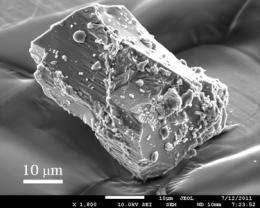Evolving planets get a bumpy ride

The formation of planets occurs under constant bombardment from particles ranging from a few nanometres to tens of kilometres in size, according to recent analyses of asteroid samples by scientists at Okayama University. The study is the first reported analysis of grains taken directly from a solar body in space.
Eizo Nakamura and colleagues at Okayama University and the Japan Aerospace Exploration Agency (JAXA) report the results from a study of the samples in the Proceedings of the National Academy of Sciences.
The Japan Aerospace Exploration Agency (JAXA) sent a probe to investigate the near-Earth asteroid 25143 Itokawa as part of the Hayabusa mission. The aim of the mission was to obtain and analyse samples of asteroids and so learn more about how the solar system evolved.
Asteroids are considered to comprise intermediate products in the evolution of solar bodies. Investigating asteroids can provide information on planetary evolution. The information that can be retrieved from meteorites – asteroids that fall to earth – is limited as a result of the significant surface changes meteorites undergo when they enter the atmosphere. In contrast the Itokawa samples comprised ‘chondritic’ material, unmodified by this sort of melting or differentiation.
The capsule containing the asteroid grains returned to Earth in June 2010. Mass spectroscopy analysis confirmed that the oxygen isotope ratios differed from stone found on Earth, confirming the extra-terrestrial origin of at least 4 of the 5 samples.
Using scanning electron microscopy, the researchers identified craters 100-200 nm in size as well as particles adhered to the asteroid surface. They suggest that a combination of disaggregation, cratering, melting, adhesion, agglutination, and implantation/sputtering affect the asteroid surface as a result of bombardment by submicrometre sized particles in space. “Impact appears to be an important process shaping the exteriors of not only large planetary bodies, such as the moon, but also low-gravity bodies such as asteroids,” explain Nakamura and his colleagues.
Among the other features observed in the grains were a type of feldspar that would have formed during slow cooling from temperatures of 860 °C. These temperatures and cooling dynamics could not have been achieved in a rock with a radius of only 300m. As a result it is likely that the asteroid Itokawa originated from a larger asteroid.
The researchers identified a considerable number of glassy particles on the asteroid surface, as well as iron particles associated with weathering processes in space from previous spectroscopy studies. However, they also suggest that previous near-infrared spectrocsopy studies may have underestimated the deposition of glassy materials and the resulting absorption.
“We suggest that the chemistry and textures of Itokawa’s surface reflect long-term bombardment of equilibrated chondritic material, at scales of 10−9 to 104 meters,” conclude the authors, adding that impact processes in general play a central role in the evolution of planetary bodies.
More information: Eizo Nakamura et al, Space environment of an asteroid preserved on micrograins returned by the Hayabusa spacecraft, Proceedings of the National Academy of Sciences, February 27, 2012. doi: 10.1073/pnas.1116236109
Journal information: Proceedings of the National Academy of Sciences
Provided by Okayama University


















